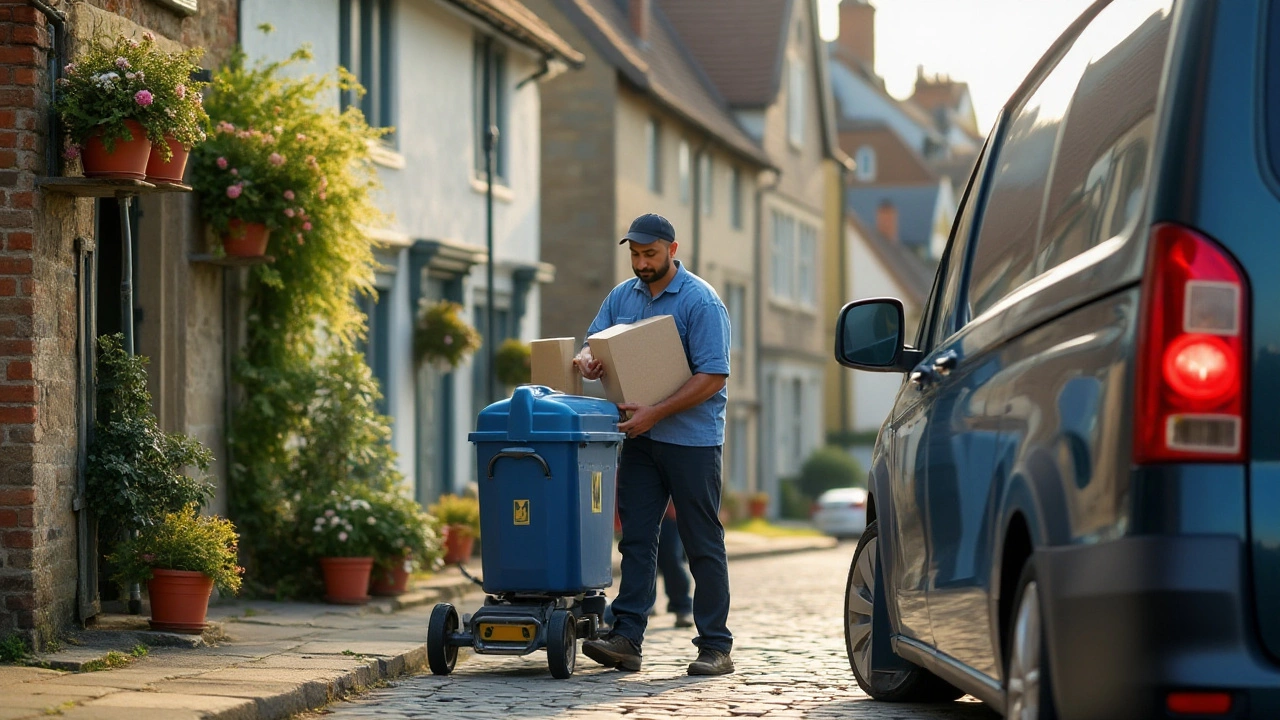Understanding Delivery Insurance Coverage: What You Need to Know

In the world of shipping and delivery, safeguarding your precious cargo with the right insurance is more crucial than ever. Imagine the peace of mind knowing that your package is protected from unforeseen mishaps during its journey. Delivery insurance comes to the rescue by offering various coverage options tailored to meet different needs, whether you're a business owner or simply someone sending a personal gift across the country.
Many people often overlook the importance of understanding what their delivery insurance covers until it's too late. And that's where this article comes into play. We'll be diving into the nitty-gritty of delivery insurance coverage, helping you navigate the complex world of policies, claims, and exceptions. By the end of this read, you'll be armed with the knowledge to choose a plan that not only suits your needs but also fits your budget.
The process of selecting the right insurance might seem daunting, but fear not—it's simpler than you think. With our guide, you’ll uncover the types of coverage available and learn how to avoid common pitfalls. Plus, we'll share practical tips on securing your shipments, ensuring they reach their destination safely. Join us as we unravel the mysteries of delivery insurance coverage and set you on a path towards worry-free shipping.
- What is Delivery Insurance?
- Types of Delivery Coverage
- How to Choose the Right Coverage
- Common Claims and Exceptions
- Practical Tips for Securing Your Shipments
What is Delivery Insurance?
Delivery insurance, often an unsung hero of the logistics world, is designed to protect your packages from various perils during transit. At its core, this type of insurance policy ensures financial compensation in the event a package is lost, damaged, or stolen while on its way to the recipient. This becomes especially important for high-value items or items that are irreplaceable in nature. As e-commerce grows, so does the need for security in transport, making delivery insurance a vital consideration.
One might wonder, why has delivery insurance become so significant? The answer lies in the sheer volume of goods being shipped daily. With billions of packages circulating the globe annually, a margin of errors is inevitable. From warehouses to customer doorsteps, parcels pass through multiple hands, each juncture presenting a risk of mishap. According to a survey by Pitney Bowes, global parcel volume is anticipated to reach over 200 billion by the mid-2020s, illustrating the scale and potential risks involved in package delivery. This underscores why ensuring your shipments is not just prudent but necessary.
Perhaps you're a small business owner shipping artisanal goods, or an individual sending a priceless heirloom to a relative. In either case, knowing that your shipment is covered can alleviate much of the stress associated with potential delivery failures. Delivery insurance coverage can vary widely from basic protection against theft to comprehensive plans that guard against everything from weather-related damage to mishandling by carriers.
"The need for package protection is echoed time and again by consumers and businesses who have experienced losses due to insufficient coverage," says Jane Doe, a renowned logistics expert and author of 'Shipping Smarts: Navigating the Delivery World'.
Not all delivery insurance policies are created equal. Some high-tier options provide compensation for indirect consequences like loss of sales or business opportunities if an essential shipment fails to arrive. Others might only cover the initial cost or declared value of the item sent. It's crucial to understand the intricacies of each policy to tailor your choice based on specific shipping needs.
For those who ship occasionally, investing in independent delivery insurance policies through third-party providers may be the most economical and practical approach. Meanwhile, businesses with frequent shipments might find it beneficial to negotiate blanket insurance policies with their shipping partners, covering multiple packages under a single agreement. This flexibility ensures a harmony between coverage and expenditure pertinent to the volume and value of shipments.
| Type of Coverage | Typical Inclusions |
|---|---|
| Basic | Protection against loss or theft |
| Comprehensive | Includes damage, theft, loss, and indirect losses |
| Custom | Tailored based on specific needs |
It’s not just about the money; ensuring your package also speaks volumes about professionalism and trustworthiness. When customers know that their products are insured, it heightens their confidence in your service and solidifies your reputation as a reliable entity. Understanding delivery insurance is no longer an option but a necessity in a world where expectations about delivery speed and reliability continue to escalate.
Types of Delivery Coverage
Delivery insurance coverage is a broad term that encompasses several types of protection policies designed to ensure the safe transit of goods. Understanding these various types of delivery insurance is key to selecting the policy that best suits your needs. The most common coverage includes standard coverage, declared value coverage, and all-risk coverage—each catering to different scenarios and levels of protection.
Standard coverage is often included within the basic services of courier companies and covers damages or losses within specific limits. For instance, many services provide automatic coverage for parcels worth up to $100. While it offers a basic safety net, it's crucial to check what exactly is covered to avoid unexpected surprises. Another type, declared value coverage, allows you to set the value of the shipment when booking. By declaring the value of your package, you can increase the coverage amount, offering a better safety net for high-value items.
One of the most comprehensive forms is all-risk coverage, which covers loss or damage due to any external cause, barring specific exclusions stated in the policy. This type of coverage is ideal for those shipping valuable or irreplaceable items. It's important to weigh the risks and decide if the high premium cost aligns with the value of your shipment.
Making the right choice often involves evaluating the nature of your business and your shipping habits. If you're sending out numerous high-value packages, all-risk coverage might be the best protection. Meanwhile, smaller businesses that focus on less expensive items may benefit more from the basic coverage included by default.
"Not understanding the extent of coverage can lead to unforeseen losses," says insurance analyst Mark Hamilton.With the right knowledge, businesses and individuals can make informed decisions, ensuring their packages are covered without overspending.
Some companies also offer liability coverage, which compensates for the cost of goods damaged or lost due to the carrier's negligence. It's important to note that not all claims are honored; specific conditions and documentation are usually required to file a claim successfully. The clarity in terms and conditions is a hallmark of reliable delivery insurance.
Consider consulting with an insurance advisor to help you navigate the intricate details of customs laws, which can vary significantly from region to region. These professionals can simplify the process, offering tailored advice that fits both your budget and business operations. Equipping yourself with comprehensive knowledge of package protection types will better safeguard your shipments and instill confidence in your clientele, as they appreciate the added assurance that their goods will arrive intact and at the right destination.

How to Choose the Right Coverage
Choosing the right delivery insurance might seem intimidating at first, but breaking it down into manageable steps can make the process much easier. First off, you need to identify what you'll be shipping. Different types of cargo may require varied levels of protection. Consider whether you're sending fragile items like glassware, or perhaps something valuable such as electronics. This will help you determine the level of coverage needed, ensuring your items are protected appropriately. High-value items often demand a comprehensive policy offering protection against theft, damage, or loss.
Another key factor is understanding the intricacies of different types of delivery coverage. Many insurers provide basic plans that cover only the basics, such as loss or theft during transit. However, if you're transporting goods internationally, you should explore a more extensive package that includes potential customs delays or overseas damage. Keep an eye on limits—some policies have caps on the amount they're willing to cover, so it's imperative to read the fine print. Evaluate your shipping frequency as well. Businesses shipping in bulk regularly might benefit from an annual policy rather than one-time coverage.
"Insurance should be tailor-made to fit the individual's needs and circumstances," suggests John Smith, a well-regarded insurance analyst at Global Shipping Solutions.
Budget is always a concern, so compare prices across several companies to see which one offers the best bang for your buck. You don't want to overspend, but at the same time, ensure the policy is robust enough to actually safeguard you when needed. Remember, sometimes the cheapest option can end up being the costliest mistake if it doesn't adequately cover your risks. Speaking to an insurance advisor or utilizing online tools to get quotes can be a practical approach to ensure you're getting the most value.
Your Shipping Destination and Its Impact
The destination plays a big role in choosing your level of coverage. Domestic shipments may present fewer risks than international ones. Shipping to countries with higher theft rates or complex customs procedures might necessitate additional protection. So, research is your friend here—knowing what to expect from customs regulations at your delivery point can help refine what package protection you pursue.
Final Tips for a Secure Selection
- Always check for customer reviews of the insurance provider; feedback can reveal hidden issues.
- Look for policies that offer flexibility to adjust as your needs change.
- Leverage any partnerships your shipping provider might have with insurers to possibly get a better rate.
In truth, selecting the right delivery insurance is all about careful consideration and a smidge of foresight. By following the guidance above, you'll be on your way to ensuring your goods are well-protected and that you can breathe easy during the shipping process. After all, delivery isn't just about getting something from point A to point B—it's about doing so safely and securely.
Common Claims and Exceptions
When it comes to filing claims under delivery insurance, there are a myriad of scenarios where coverage kicks in. Common claims typically include losses from theft, damage during transit, and accidental misdelivery. In the bustling world of logistics, packages face the risks of mishandling or exposure to harsh conditions. One typical claim could be when a parcel arrives damaged, and the contents within are no longer usable or in the condition they were when sent. Similarly, if a package is stolen after being delivered to the wrong address, this too may justify a claim. It's crucial that claimants adhere to the insurer's filing process, which usually involves proving the package's worth and the extent of the damage. Documentation like photos and receipts can significantly bolster your case.
Exceptions, however, form an integral part of delivery insurance policies. These are conditions under which the insurer may deny a claim. Common exceptions revolve around improper packaging, which shifts the burden of responsibility back to the sender, emphasizing the importance of packing items securely. Other typical exceptions involve prohibited items that were undeclared at the time of shipping, which are often listed explicitly in the terms and conditions of the insurance. Each insurer has a different list of non-coverable items, ranging from perishable goods to high-value jewelry. The sender must keep this in mind during the planning phase of their shipment to avoid unwelcome surprises when a claim is filed.
Interestingly, the world of delivery insurance has seen interesting developments in recent years, with some companies beginning to cover previously excluded areas. According to the latest report from the Shipping and Transport Research Institute, about 15% of insurers now offer limited coverage for electronic devices such as laptops or smartphones, which were traditionally high-risk exclusions. This industry shift highlights a growing recognition of changing consumer needs and the competitive nature of shipping coverage. A quote from Jean-Luc Florennce, a leading expert in logistics and transport insurance, underscores this trend:
"The landscape of delivery insurance is evolving, accommodating broader coverage areas. Insurers are starting to see the value in addressing modern shipping demands."This indicates a progressive movement towards more inclusive policies, but highlights the need to read the fine print carefully to understand what is and isn’t covered.
For those looking to delve deeper into ensuring that their claims are accepted, here are some pivotal steps to follow: First, always check the terms and exclusions of your policy before shipping, allowing you to make any necessary adjustments. Second, use robust packaging materials complementing the nature of the item being shipped. Third, take photographs of the item pre-shipment as proof of condition, a supporting document should there be any need to substantiate a claim. Lastly, keep all related receipts and documents handy, as these form the foundation of your claim's legitimacy. Recognizing the interplay between claims and exceptions can essentially empower you as a sender to maximize your chance of a favorable outcome should issues arise.

Practical Tips for Securing Your Shipments
When it comes to keeping your packages safe and sound during their journey, there are several strategies you can employ. These techniques not only help in protecting the contents but also provide a sense of assurance that your delivery will arrive intact. One of the essential steps is to select the right packaging materials. For instance, a sturdy cardboard box is often preferred for items susceptible to damage. It provides a strong outer shell that can withstand the rough and tumble experienced during transit. Inside the box, using bubble wrap or foam peanuts can significantly reduce the impact and prevent breakage.
An important aspect of securing your shipment is labeling. Ensuring that all labels are legible and accurately placed can help prevent mishandling. Using waterproof markers is a good idea, especially if your package might encounter wet conditions. Moreover, prominently display any handling instructions like "Fragile" or "Handle with Care" to alert handlers about the care needed. Proper labeling also extends to the address. Double-check that the recipient's details are correct to avoid misrouting.
Using Delivery Insurance to Your Advantage
Another crucial step is acquiring appropriate delivery insurance. This acts as a safety net against unforeseen events such as loss, theft, or damage. According to the Federal Maritime Commission, "Insurance is pivotal—without it, shippers bear the full brunt of potential losses."
"Insurance is pivotal—without it, shippers bear the full brunt of potential losses." - Federal Maritime CommissionIt's wise to assess the value of your shipment and choose a coverage plan accordingly. Remember, each carrier has its insurance options, so exploring all available choices can lead to considerable savings.
Enhancing Security through Tracking and Reliable Couriers
Tracking packages is another effective way to ensure they reach their destination safely. Most major courier services offer real-time tracking, allowing you to monitor your shipment from dispatch to delivery. This transparency not only mitigates anxiety but also identifies potential delays. Selecting a reliable courier service cannot be understated; their reputation often aligns with their handling efficiency. Researching customer reviews and ratings can be a good indicator of their performance.
Finally, consider the timing of your deliveries. Sending packages early in the week minimizes the risk of weekend delays that can occur with some courier services. Additionally, maintaining a record of your shipments, including tracking numbers and transaction receipts, can expedite any claims process in case issues arise during transit. Following these tried-and-true practices will undoubtedly increase the likelihood of your shipments arriving securely and on time.